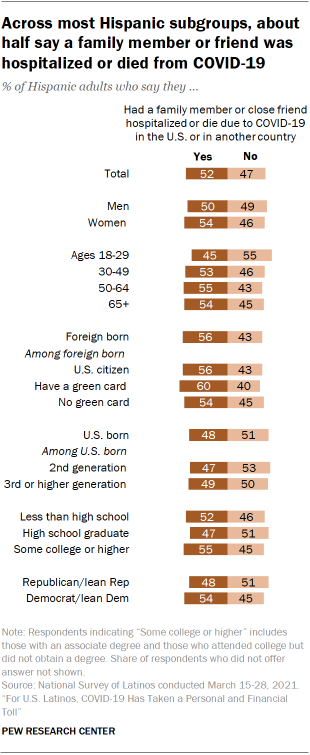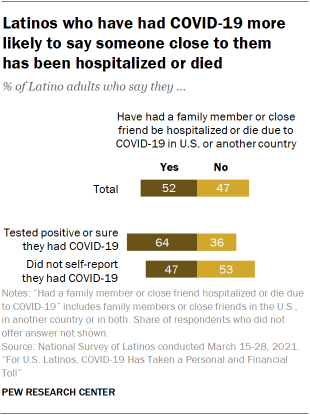During the pandemic, Hispanics have been at a higher risk of hospitalization or death from COVID-19 than some other racial and ethnic groups in the U.S., in part due to large numbers who lack access to health care and have jobs that put them at greater risk of exposure to the virus. Hispanics have accounted for 19% of reported COVID-19 deaths and 29% of COVID-19 cases in the country as of June 29, 2021, according to data reported to the Centers for Disease Control and Prevention.5
The coronavirus pandemic has had a wide reach in the Latino population. Substantial shares across age groups, immigration status, education and party affiliation say someone close to them has become seriously ill due to COVID-19.
Half of U.S. Hispanics say someone close to them has been hospitalized or died from COVID-19
About half (52%) of Latino adults in the U.S. say a family member or close friend living in the U.S. or in another country has been hospitalized or died from COVID-19. And 28% of Latinos say they have either tested positive for COVID-19, tested positive for antibodies or are “pretty sure” they had the virus even though they did not have a positive test. Overall, 62% of Latino adults either have had COVID-19 themselves or have a relative or close friend who has been hospitalized or died from the virus.6
The reach of COVID-19 varies little across demographic subgroups, highlighting the pandemic’s broad impact among Latinos, though immigrants and adults ages 30 and older were slightly more likely to say someone close to them has fallen seriously ill due to COVID-19. Among Latino immigrants, more than half (56%) say a family member or close relative has been hospitalized or died from COVID-19, compared with 48% of those who are U.S. born who say the same, according to the survey. This in part reflects that the coronavirus pandemic continues to hit Latin American and Caribbean nations especially hard. Meanwhile, 54% of Latinos ages 30 and older say someone close to them has been hospitalized or died from COVID-19, compared with 45% of those ages 18 to 29 who say the same.
Young Latinos more likely than older adults to say they’ve had COVID-19
Some three-in-ten Latinos (28%) say they have tested positive for COVID-19 or antibodies or have been pretty sure they have had it, with similar shares across most demographic subgroups saying they’ve had the disease. Yet there are differences by age in the shares who say they have had COVID-19.
Roughly one-in-three Hispanics ages 18 to 29 and 30 to 49 say they have had COVID-19 (32% and 31%). By comparison, 24% of Hispanics ages 50 to 64 say they have had COVID-19, while those 65 and older (17%) are least likely to say they have had COVID-19.
Meanwhile, the share of Latinos who say they have had or think they had COVID-19 also differs by their work situation. About a third (34%) of Latinos who work outside their home say they have had COVID-19, compared with 24% who say the same among those who have worked mostly or entirely from home, or have not been employed since February 2020.
About two-thirds of Latinos (64%) who say they have tested positive for COVID-19 or are “pretty sure” they’ve had the virus say a close friend or family member has been hospitalized or died due to the virus. By comparison, among Latinos who say they have not contracted COVID-19, 47% say they’ve had someone close to them be hospitalized or die due to it. Still, no matter their experience with COVID-19, about half of Latino adults (52%) say someone close to them has fallen seriously ill from the virus.
While the share of U.S. Hispanics who said they intended to get the vaccine rose among U.S. Hispanics earlier in the year, vaccination rates among the group are lower compared with the general population. Among those who are not vaccinated for COVID-19, U.S. Hispanics are more likely than other groups to say they would like to get vaccinated as soon as possible, though many express concerns about missing work due to the side effects or mistakenly think they have to pay for the vaccine.
In recent months, U.S. vaccinations to prevent COVID-19 ramped up and then slowed. Though vaccines are now widely available and all adults and children as young as 12 are now eligible, the number of daily doses administered is down from its peak in April. This has led authorities and businesses to launch incentive programs for residents to get vaccinated.





